|
THE OCEAN OF COMPASSION
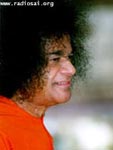 Swami
often says that man is a limb of society; society is a limb
of mankind; mankind is a limb of Nature; and Nature is a limb
of God. This is the hierarchical and organic relationship
between man and God. If man forgets this, he can and does
get into all kinds of problems, as in fact is presently happening. Swami
often says that man is a limb of society; society is a limb
of mankind; mankind is a limb of Nature; and Nature is a limb
of God. This is the hierarchical and organic relationship
between man and God. If man forgets this, he can and does
get into all kinds of problems, as in fact is presently happening.
Man today has
completely forgotten that Nature does not stand alone, and
that it is the Creation of God. Out of compassion, God has
packed Nature with innumerable bounties, all for man to use
and enjoy. However, the use of these gifts must be within
reasonable bounds, going hand in hand with the expression
of gratitude to God. But alas, the use [or rather the exploitation]
of these bounties has become shockingly reckless, and there
is no gratitude either. Under such circumstances, Nature does
not remain a silent spectator. Incredibly patient she is but
when aroused, her fury is unmatched. Using the law of reflection,
reaction, resound, she punishes man via murderous tornadoes,
terrifying typhoons, grim famines, deadly epidemics, harsh
droughts, disastrous floods, fearsome avalanches, massive
landslides, fiery volcanic eruptions, devastating earthquakes,
and what not.
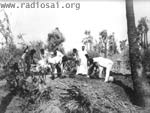 Meanwhile,
what should one do when disaster strikes? There are some that
say, "It is all God's will. Those who
suffer are destined to do so. Let us leave them alone."
This is an incredibly ridiculous argument. If it were taken
seriously, there would be no room for any doctors! Baba makes
it very clear that we have no business to sit in judgement
on others. Rather, we must rush to help - that is what the
famous parable of the Good Samaritan is all about. And just
so that we do not forget, Swami repeats that lesson by His
own personal example any number of times. His compassionate
response at the time of the Andhra cyclone in 1977, and the
Gujarath earthquake in 2001 are two just two such instances. Meanwhile,
what should one do when disaster strikes? There are some that
say, "It is all God's will. Those who
suffer are destined to do so. Let us leave them alone."
This is an incredibly ridiculous argument. If it were taken
seriously, there would be no room for any doctors! Baba makes
it very clear that we have no business to sit in judgement
on others. Rather, we must rush to help - that is what the
famous parable of the Good Samaritan is all about. And just
so that we do not forget, Swami repeats that lesson by His
own personal example any number of times. His compassionate
response at the time of the Andhra cyclone in 1977, and the
Gujarath earthquake in 2001 are two just two such instances.
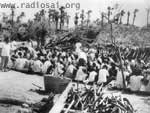
A
terror-striking cyclone had hit the Andhra coast in 1977.
The cyclone brought in its wake, a twenty-foot tidal wave
[i.e., about seven metres high], that spread itself over a
large part of the coast and penetrated about thirty miles
[about fifty kilometres] inland, before spending its fury.
The devastation inflicted by the combined force of wind and
water was enormous. Tens of thousands died, cattle perished
in large numbers, scores of villages were wiped out, and an
enormous number of coconut trees were uprooted. The survivors
were confronted by disease, despair, and decimation. Bhagavan
directed the Seva Dal from Andhra to rush to the area. Truckload
of clothes, rugs, and whatever could be gathered were speedily
despatched …….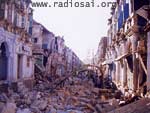 Four relief camps were set up. Massive provisions and materials
being carried by devotees as headloads. They had to wade through
slush and mire, through thick clouds of stench from rotting
corpses and carcass. Indeed the first task was to bury or
burn these, which they found in heaps on the ground and even
on trees and bushes. Kitchens worked round the clock in four
strategic centres for over a month. Food was sent from there
to several places, including remote ones ….. Besides
this, the Seva Dal helped to build huts. They also gave away,
utensils, clothes, and rugs, as a part of the rehabilitation.
When the Seva activities finally came to a close, the volunteers
were happy that the faces of the masses around them were bright
with gratitude and devotion for Bhagavan.
Four relief camps were set up. Massive provisions and materials
being carried by devotees as headloads. They had to wade through
slush and mire, through thick clouds of stench from rotting
corpses and carcass. Indeed the first task was to bury or
burn these, which they found in heaps on the ground and even
on trees and bushes. Kitchens worked round the clock in four
strategic centres for over a month. Food was sent from there
to several places, including remote ones ….. Besides
this, the Seva Dal helped to build huts. They also gave away,
utensils, clothes, and rugs, as a part of the rehabilitation.
When the Seva activities finally came to a close, the volunteers
were happy that the faces of the masses around them were bright
with gratitude and devotion for Bhagavan.
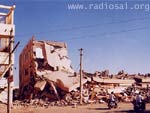 It
was 8.45 A.M. on 26th January, 2001, a day celebrated in India
as Republic Day. In Delhi the Nation's Capital, an impressive
parade is held in the morning at which the President takes
the salute. Around the same time, parades and flag-hoisting
ceremonies are held all over India, particularly in schools.
In Gujarat, many children were marching to their schools at
that hour. And then the earth shook fearsomely, like never
before. Buildings crumbled and in a few quick seconds, thousands
were trapped under the debris, including school children on
their way to parades. Entire villages were wiped out just
like that, in barely a few minutes. Death did not make any
distinctions - the young, the old, the rich, and the poor,
all became equal before it. It
was 8.45 A.M. on 26th January, 2001, a day celebrated in India
as Republic Day. In Delhi the Nation's Capital, an impressive
parade is held in the morning at which the President takes
the salute. Around the same time, parades and flag-hoisting
ceremonies are held all over India, particularly in schools.
In Gujarat, many children were marching to their schools at
that hour. And then the earth shook fearsomely, like never
before. Buildings crumbled and in a few quick seconds, thousands
were trapped under the debris, including school children on
their way to parades. Entire villages were wiped out just
like that, in barely a few minutes. Death did not make any
distinctions - the young, the old, the rich, and the poor,
all became equal before it.
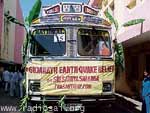 As
news trickled in from the disaster area, gloom descended over
the Nation. The cry of anguish reached even far off lands,
and help poured in. Baba was in Bangalore then, spending some
time there after the inauguration of the big Hospital. People
rushed to Him to give the news about the disaster. Quietly
He listened. He of course knew much before anyone else when
the disaster actually struck and also why; but He did not
give any inkling of what He knew. Silently and most unobtrusively,
He organised help and relief in typical Sai fashion, as soon
as He returned to Prasanthi Nilayam. Trucks were lined up,
loaded with food and other relief items, and given a loving
send off with devotees singing Bhajans and Swami personally
blessing the convoy. While Seva Dal volunteers from Gujarat
and the neighbouring state of Maharashtra were already on
duty at the distress spot, Baba added a sweet touch by specially
sending some of the people from Prasanthi Nilayam, to go all
the way to Gujarat, stay there for as many days as were required,
and supervise the distribution. In many ways, this was reminiscent
of His sending Mr. Kasturi to supervise Seva during the Andhra
cyclone of the seventies. As
news trickled in from the disaster area, gloom descended over
the Nation. The cry of anguish reached even far off lands,
and help poured in. Baba was in Bangalore then, spending some
time there after the inauguration of the big Hospital. People
rushed to Him to give the news about the disaster. Quietly
He listened. He of course knew much before anyone else when
the disaster actually struck and also why; but He did not
give any inkling of what He knew. Silently and most unobtrusively,
He organised help and relief in typical Sai fashion, as soon
as He returned to Prasanthi Nilayam. Trucks were lined up,
loaded with food and other relief items, and given a loving
send off with devotees singing Bhajans and Swami personally
blessing the convoy. While Seva Dal volunteers from Gujarat
and the neighbouring state of Maharashtra were already on
duty at the distress spot, Baba added a sweet touch by specially
sending some of the people from Prasanthi Nilayam, to go all
the way to Gujarat, stay there for as many days as were required,
and supervise the distribution. In many ways, this was reminiscent
of His sending Mr. Kasturi to supervise Seva during the Andhra
cyclone of the seventies. 
For most volunteer organisations, service ended after the
items had been distributed. With Swami it was quite different.
He had given instructions that these villages [which had been
reduced to ghost-towns] have to be rebuilt by Sai effort -
that is the most wonderful and unusual part of the Seva rendered
in Gujarat. In other words, with Sai it is not just relief
but also rehabilitation. That is real concern and that is
real compassion. Long after other volunteers have returned
their respective bases, Sai volunteers are still in Gujarat,
helping to restore normalcy.
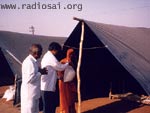 The
Gujarat earthquake taught many lessons. The first was a reminder
that Nature is not to be treated lightly. In fact, in His
Discourse on the occasion of Sivarathri that followed the
quake, Baba reminded devotees of this fact. Next, by His action,
Swami also firmly refuted the flimsy excuse sometimes given
for inaction, namely that people who suffer are destined to
do so. He made it abundantly clear that we not here to analyse
the Law of Karma but to render service, irrespective of the
antecedents of the recipients of the service - that is what
true Love and compassion are all about. The
Gujarat earthquake taught many lessons. The first was a reminder
that Nature is not to be treated lightly. In fact, in His
Discourse on the occasion of Sivarathri that followed the
quake, Baba reminded devotees of this fact. Next, by His action,
Swami also firmly refuted the flimsy excuse sometimes given
for inaction, namely that people who suffer are destined to
do so. He made it abundantly clear that we not here to analyse
the Law of Karma but to render service, irrespective of the
antecedents of the recipients of the service - that is what
true Love and compassion are all about.
|